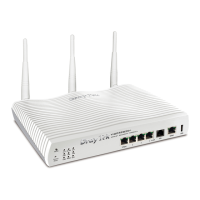
Do you have a question about the Draytek Vigor 2820 Series and is the answer not in the manual?
| VPN Concurrent Users | Up to 50 |
|---|---|
| Firewall Type | Stateful Packet Inspection (SPI) |
| Content Filtering | Yes |
| DoS/DDoS Protection | Yes |
| Maximum VPN Tunnels | 50 |
| VPN Support | Yes |
| LAN Ports | 4 |
| VPN Protocols | IPSec, PPTP, L2TP |
| Wireless Standard | 802.11n |
Lists the trademarks used in the document, including Microsoft and Apple.
Covers essential safety guidelines, warranty information, and firmware/tools updates.
States compliance with EC directives for Vigor2820 Series routers.
Details FCC compliance for Class B digital devices and radio frequency interference.
Details the router's front panel LEDs and connectors for different models.
Lists all the items included in the Vigor2820 router package.
Explains the ISDN TE interface for analog signal transmission via the internet.
Describes the ISDN NT port for connecting general phones to the network.
Details the LED indicators and their meanings for the Vigor2820 model.
Explains the function of each interface connector on the Vigor2820.
Instructions for restoring the router to its factory default settings.
Defines the purpose of each interface port on the router.
Details the LED indicators and their meanings for the Vigor2820n model.
Explains how to enable or disable the wireless connection using the WLAN button.
Instructions for restoring the router to its factory default settings.
Describes the function of each interface connector on the Vigor2820n.
Details the LED indicators and their meanings for the Vigor2820Vn model.
Explains the LED status for Phone 1/2 and Line ports on the Vigor2820Vn.
Explains how to enable or disable the wireless connection using the WLAN button.
Instructions for restoring the router to its factory default settings.
Details the LED indicators and their meanings for the Vigor2820VS model.
Explains the NT/TE modes and LED indicators for ISDN/Phone S0 ports.
Details the NT/TE modes and LED indicators for ISDN/Phone S0 ports.
Instructions for restoring the router to its factory default settings.
Details the LED indicators and their meanings for the Vigor2820VSn model.
Explains the NT/TE modes and LED indicators for ISDN/Phone S0 ports.
Details the NT/TE modes and LED indicators for ISDN/Phone S0 ports.
Instructions for restoring the router to its factory default settings.
Lists and illustrates the items included in the Vigor2820 router package.
Shows different power adapter types based on country.
Step-by-step guide for physically connecting the router and its components.
Instructions for connecting ADSL and second WAN ports to modems/splitters.
Explains ISDN S0 port modes (NT/TE) and phone connections for Vigor2820 S models.
Guidance on connecting analog phones to the router's phone ports.
Illustrates the connection for ISDN TE mode, indicating green LED for ISDN-TE.
Illustrates the connection for ISDN NT mode, indicating orange LED for ISDN-NT.
Instructions for setting up a printer for network sharing via the router.
Steps to configure printer settings in Windows XP/2000 for network printing.
Steps to add a new printer using the Windows Add Printer Wizard.
Guide to selecting the correct port, like Standard TCP/IP Port, for the printer.
Steps to configure the Standard TCP/IP port for the printer connection.
Selecting 'Generic Network Card' as the adapter type in the wizard.
Selecting the correct printer driver from the manufacturer list.
Setting the LPR protocol and queue name for network printing.
Guidance on checking printer compatibility on the DrayTek website.
Notes on printing requests via LAN ports only, not WAN.
Steps to access the router's web interface and use the Quick Start Wizard.
How to connect to the router's IP address (192.168.1.1) via a web browser.
Explains the role of the Vigor router as an Access Point in wireless networks.
Guide to configuring general wireless LAN settings like SSID and mode.
How to enable the wireless function by checking the 'Enable Wireless LAN' option.
Setting the SSID (network name) for the wireless LAN.
Choosing the wireless mode (e.g., 11b+11g+11n) for client compatibility.
Choosing security modes like WEP, WPA/PSK, WPA2/PSK for wireless data.
Entering the PSK for WPA encryption to secure wireless communication.
Setting 64-bit or 128-bit WEP keys for wireless encryption.
Notes on matching encryption bit length and sharing keys across wireless devices.
Steps to verify hardware status by checking power, cables, and ACT LED.
Ensuring ACT LED blinks and LAN LED is bright for correct hardware status.
Steps to check and configure network settings in Windows Control Panel.
Configuring IP address and DNS server settings for automatic acquisition.
Setting up macOS network settings to use DHCP for IP address assignment.
Steps to apply network configuration changes in macOS.
Using the ping command in Windows Command Prompt to check router connectivity.
Using the ping command in macOS Terminal to verify router link status.
Reviewing WAN connection settings for PPPoE or other ISP configurations.
Checking PPPoE username and password settings for ISP access.
Details VPI, VCI, encapsulation, and authentication for PPPoE/PPPoA.
Configuration for MPOA connections, including IP address and subnet mask.
How to perform a factory reset using the router's web interface (System Maintenance).
Using the physical RST button to restore the router to factory default settings.
Selecting 'Using factory default configuration' to reboot the router.
Detailed steps for performing a hardware reset using the RST button.
Instructions on contacting the dealer or support for unresolved issues.
Provides the support email address (support@draytek.com) for inquiries.